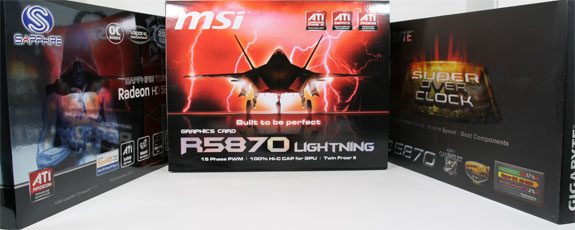Overclocked: Our Custom Radeon HD 5870 Roundup
by Ryan Smith on May 19, 2010 11:53 AM ESTFans of custom video cards have undoubtedly found themselves a bit disappointed with the Radeon HD 5800 series. Due to a perfect storm of low GPU yields from TSMC and NVIDIA’s late arrival with the GTX 400 series, the first 6 months for the 5800 series was nothing other than bonkers. AMD was selling GPUs to their partners as fast as they could come out of TSMC, and their partners were selling finished boards to OEMs and-end users alike as fast as they could be assembled. Even at prices over MSRP, the 5800 series flew off the shelves, leaving AMD’s partners with little-to-no supply of GPUs to tinker with. Custom 5800 series cards effectively took a 6 month vacation.
That wait finally came to an end in the Spring of 2010, as an increase in GPU supplies allowed AMD’s partners to catch their breathes and focus on their custom cards. With 6 months under their belts AMD’s partners were able to come up with a variety of designs for their custom cards, and today we’re going to be looking at a trio of custom Radeon HD 5870s: Sapphire’s Radeon HD 5870 Toxic 2GB, MSI’s Radeon HD 5870 Lightning, and Gigabyte’s Radeon HD 5870 Super Overclock.
| Sapphire 5870 Toxic 2GB | MSI 5870 Lightning | Gigabyte 5870 Super Overclock | |
| Core Clock | 925MHz | 900MHz | 950MHz |
| Memory Clock | 1.225GHz (4.9GHz data rate) GDDR5 | 1.2GHz (4.8GHz data rate) GDDR5 | 1.25GHz (5GHz data rate) GDDR5 |
| Frame Buffer | 2GB | 1GB | 1GB |
| Voltage Control | No | Yes (1.35v) | Yes (1.28v) |
| Price Point | $499 | $479 | $499 |
Custom cards are almost always interesting for a few different reasons. Often it’s a chance to see what AMD’s partners learned about a GPU over the preceding months and are trying their hand at producing something cheaper. Other times it’s throwing cost-efficiency out the window in the name of better components and coolers. And yet in other times it’s about producing a card that fills a specific niche, such as hardcore overclockers or users with cramped cases.
Today we’re looking at 3 such cards, each taking a different approach in their custom design. MSI’s Lightning is the overclocker and Sapphire’s Toxic is the build-it-better card, while Gigabyte’s Super Overclock attempts to straddle the line between the two by doing both at once. Ultimately however all 3 shoot for the same goal even if they go about it in different ways: maximizing performance.
Finally it shouldn’t come as a surprise that with all 3 cards designed to be superior 5870s that they command a superior price. At $480-$500, all 3 cards are solidly in the luxury category.












43 Comments
View All Comments
Ryan Smith - Friday, May 21, 2010 - link
I have one, but it just arrived, which was after the deadline for this article. We'll have a review of it up next week.Etern205 - Friday, May 21, 2010 - link
Looking forward to that article, can't wait to read it.swing848 - Saturday, June 26, 2010 - link
You may have come close to hitting ATI's next GPU when you mentioned "4890-style respin". Southern Islands is highly anticipated.